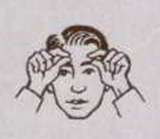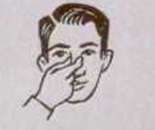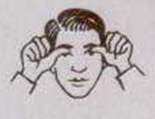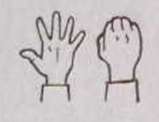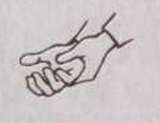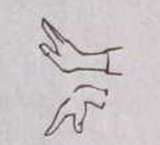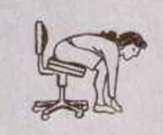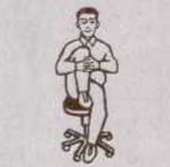
- •Introduction
- •Topic 1: principles of translation
- •1.1. Notes on the Profession of the Translator
- •1.2. Professional pride
- •1.3. Income
- •1.4. Speed
- •1.5. Enjoyment
- •Basic interpretation and linguistic terms used in the Topic
- •Keeping Trees Healthy and Safe
- •Topic 2: theory of interpretation
- •2.1. Background of interpretation theory (it)
- •2.2. First translation of the Bible as a milestone in the history of interpretation and the development of world civilization.Later history of interpretation
- •St. Jerome’s Oath
- •2.3. Deciphering the inscriptions on the Rosetta stone
- •2.4. A brief history of interpretation in the 20th Century
- •Birds and Butterflies
- •Health and Natural Balance with Patchouli
- •Topic 3: interpretation and contemporary life
- •3.1. XX century as a “golden age” of interpretation
- •3.2. Conference interpreting, professional training and diplomatic interpretation in XX century
- •3.3. Stagnation in economy – boom of interpretation
- •3.4. Interpretation in the New Millennium
- •3.5. The Very Beginning of Simultaneous Interpretation
- •Microbial Insecticides
- •Topic 4: interpretation activity
- •4.1. Translation and Interpretation Modes
- •4.2. Specific Skills required for interpreting
- •4.3. Simultaneous translation as a special kind of translating
- •4.4. Professional ethics and moral code of interpreters
- •Basic interpretation and linguistic terms used in previous topics
- •Big agribusiness draws cash
- •Topic 5: perception and understanding of messages in interpreting
- •5.1. Sense Perception and Understanding
- •5.2. The “Inner Speech” of the Interpreter
- •5.3. Interpreting without “Understanding” the Sense
- •Basic interpretation and linguistic terms used in the topic
- •1.Beneficial Insects
- •2. Kozak boat discovered in Dnipro River
- •Topic 6: types of contexts and contextual relationships in oral discourse
- •6.1. Text, Context and Discourse
- •6.2. Types of Contexts and Contextual Relationships
- •6.3. Recommendations for interpreters
- •Basic interpretation and linguistic terms used in topic 6
- •1.A Diet of Worms and Butterflies
- •2.Solarizing Soil
- •Topic 7: semantic aspects of interpretation
- •7.1. Semantic Structure of the Oral Message and its Main Components
- •7.2. The Role of the Rhematic Components
- •In Comprehending and Interpreting Oral Messages
- •7.3. Rendering “evaluative component” of messages in interpreting
- •Basic interpretation and linguistic terms used in topic 7
- •The Potential of Natural Fertilizers
- •Open Heart Surgery: a Matter of Life and Death
- •Topic 8: semantic redundancy of oral messages. Interpreter's note–taking
- •8.1. Semantic Redundancy as one of the Main Properties of Oral Discourse
- •8.2. Ways of Ensuring Semantic Redundancy of Oral Messages
- •8.3. Semantic Redundancy: Recommendations for Interpreters
- •8.4. Interpreter's Note–taking
- •Basic interpetation and linguistic terms used in topic 8
- •How the Zero was Discovered
- •Legacy of Death, bad Health lingers from Chornobyl blast
- •Topic 9: lexical aspects of interpretation
- •9.1. The Notion of the “Focus of Meaning”
- •9.2. Subject Field Terms: Ways of Interpreting Them
- •9.3. Clichés and Idioms as an Interpretation Problem
- •9.4. “Troublemaking” Lexical Units: Numerals, Proper Names, Specific Items of the National Lexicon, Abbreviations, Acronyms and “Misleading Words”
- •Basic interpretation and linguistic terms used in topic 9
- •Blood-sucking leeches popular for treatments
- •Topic 10: "gaps" in perception of oral discourse and ways of "filling them in" in interpreting
- •10.1. The Notion of "Gaps" in Perceiving Original Texts
- •10.2. Phonological "Gaps"
- •10.3. Lexical "Gaps"
- •10.4. Grammatical "Gaps"
- •10.5. Ways of Filling in the "Gaps" in Interpreting
- •10.6. Ways of Fighting Phonological Complications Caused by Accents and Dialects
- •Basic interpretation and linguistic terms used in topic 10
- •Life without It is only Silence
- •Topic 11: problems of translating idioms
- •11.1. Knowing Idioms is the Way to Speak Like a Native
- •11.2. Grammatical Nature of Idioms
- •11.3. Etymology of Idioms
- •11.4. How to Learn Idioms and Practice Them
- •Basic interpretation and linguistic terms
- •Tricky translations
- •In the text below you will find various word combinations using the word “job”. Their translations into Ukrainian follow in brackets:
- •Looking for a job
- •Topic 12: levels and components of interpretation. Interpreter’s challenges. Conference interpreting
- •12.1. Communication during Two-way Interpretation
- •Interpreter
- •12.2. Two Levels of Interpretation
- •12.3. Triad of Interpretation Process
- •12.4. Specifics and Situations in Interpreting Process
- •12.5. Factor of Time
- •Basic interpretation and linguistic terms
- •One monument to two events: Christianization, municipal rights
- •Farmland Moratorium end likely to be Unpredictable
- •Topic 13: precision and basis information, their distinctions and importance for interpretation adequacy
- •13.1. Constituents of Precision and Basis Information
- •13.2. Rendering pi in the Process of Interpretation
- •13.3. Undesirable Situations of Two-way Interpretation. Interpretation Pitfalls and Traps – How to Avoid Them
- •Basic interpretation and linguistic terms used in topic 13
- •The Brain’s Response to Nicotine
- •The Braine Response to Methamphetamine
- •Why I am a Pilot
- •Topic 14: characteristic peculiarities of professional interpretation
- •14.1. Intellectual Requirements
- •14.2. Requirements to Interpretation Adequacy
- •14.3. Memory and Interpretation
- •Organic farming takes root in countryside as people seek healthier food alternatives
- •Topic 15: analysis and synthesis during
- •Interpretation process
- •15.1. Two Stages of Interpretation Process
- •15.2. Understanding and Extraction of Meaningful Units
- •1.Hearing and the Types of Noises
- •2. Guess and Intuition
- •3. To See a Speaker
- •4. Automatism of Synthesis
- •5. Complicated is Simpler
- •15.3. Interpretation Typology
- •15.4. Constituents of Training Interpretation
- •15.5. Constituents of Real Interpretation and Ways of Achieving Adequacy
- •15.6. Subtypes of Professional Interpretation
- •The Price of Progress
- •Topic 16: hearing as the basic requirement to understanding
- •16.1. Hearing
- •16.2. The language of the original speech
- •16.3. The country of the speaker
- •16.4. The case of the speaker who uses a foreign language
- •16.5. Accents
- •16.6. Provincialisms
- •16.7. Subject Matter
- •16.8. General Culture
- •Topic 17: basic types of professional two-way interpretation (pti)
- •17.1. Dialogue Translation
- •17.2. Informal Two-way Interpretation Without Note-making
- •17.3. Official Two-way Interpreting Without Note-taking (Liaison Formal Interpreting)
- •17.5. Consecutive Discourse Interpreting
- •If salt loses its flavour
- •After losing West’s trust, ag firms looking to China
- •Basic Interpretation Analogues for the Text
- •Topic 18: combined types of interpretation
- •18.1. Sight translation
- •18.2. Sight translation with the help of dictaphone
- •18.3. Cinema/Video/tv-translation
- •18.4. Cinema/Video/tv-translation Without Preparation
- •18.5. Cinema/Video/tv-translation with Preliminary Preparation
- •18.6. Screen Translation as a Combined Type of Interpreting
- •Ukrainian exodus to North America
- •Topic 19: specialized interpretation
- •19.1. Details of Working in Different Spheres of Professional Communication
- •19.2. Forms of Initial Voice Information (for all Genres)
- •19.3. General-political Informational (Diplomatic) Discourse/Dialogue Interpreting
- •19.4. Phraseology in Interpretation
- •Donors Help Ukraine Cut High Infant Mortality Rate How Ukraine is changing childbirth practices
- •Topic 20: specialized interpretation (Continued)
- •20.1. Scientific and Technical Translation (Performances, Seminars, Lectures, Reports)
- •20.2. Special Terminological Abbreviations (Reductions, Shortenings)
- •20.3. Scientific-popular Translation (Lecture, Conversation, etc.)
- •As Demand for Rice Climbs, International Trade Falls
- •Vietnam pledges to punish rice speculators
- •Topic 21: specialized interpretation (Continued)
- •21.1. Judicial Two-way Interpreting
- •21.2. Sermon (Religious Genre)
- •21.3. Art Criticism Genre (Lecture, Excursion, Report)
- •Make oral translation of the sentences, paying attention to the adverb never, stylistic invertion and some other lexical and grammatical nuances:
- •The Kyiv-Pechersk Lavra
- •The Grounds of the upper Lavra
- •The Holy Trinity Gate Church
- •The Church of St. Nicolas
- •The Cells of the Councel Elders
- •Topic 22: language, speech and presentation skills
- •22.1. Culture of Language and Speech
- •22.2. Culture of Language and General Culture
- •22.3. Literary Language Norm
- •22.4. External Culture of Speech in the Process of Interpretation
- •22.5. Some Recommendations
- •22.6. Typical Mistakes in the Process of Interpretation
- •22.7. Interpretation Traps. Pitfalls and Gaffes in Grammar, Style and Lexis
- •22.8. Paradoxical Mistakes. Paralysis by Analysis
- •Applications of Agroecology
- •Topic 23: theory of interpreter’s note-taking
- •23.1. General Ideas
- •23.2. Type of Notes
- •23.3. Logical Analysis
- •23.4. Language of the Notes
- •23.5. Symbols and Abbreviations
- •Specific types of fish farms
- •Integrated recycling systems
- •Indoor fish farming
- •Topic 24: theory of interpreter’s note-taking (Continued)
- •24.1. Interrelation of Ideas
- •24.2. Preparation
- •24.3. Rearrangement of the Speech
- •24.4. Poetry
- •Pellagra
- •Topic 25: simultaneous translation
- •25.1. Psychological, Physical, and Linguistic Difficulties of Simultaneous Translation
- •25.2. Difference Between Professional Simultaneous Interpretation and Other Kinds of Interpretation
- •25.3. The Main Requirements to Professional Simultaneous Interpretation
- •Basic interpretation and linguistic terms used in topic 25
- •The Koala and Its Amazing Features
- •Topic 26: functional system of simultaneous interpretation. Anticipation in simultaneous interpretation
- •26.1. Functional System of Simultaneous Interpretation
- •26.2. Anticipation in Simultaneous Interpretation
- •The Power Plant in the Microcosmos: The atp Synthesis
- •Topic 27: compression and expansion
- •27.1. Compression and its Types in Simultaneous Interpretation Compression
- •27.2. Syllabic and Syntactic Compression
- •27.3. Lexical and Semantic Compression
- •27.4. Expansion in Simultaneous Interpretation
- •Topic 28: grammatical difficulties турical of interpretation
- •28.1. Grammatical Difficulties in Understanding Oral Texts
- •28.2. Rendering the English Articles
- •28.3. Rendering the Tense Forms of the Verb
- •28.4. Difficulties in Rendering the Forms Expressing Unreality
- •28.5 Difficulties in Rendering of the Affirmative and Negative Constructions
- •28.6 Comprehension of the "Inner Syntactic Structure" of the Source Language Messages by Simultaneous Interpreters
- •28.7. Word Order and Functional Sentence Perspective of Messages: Recommendations for Simultaneous Interpreters
- •28.8 Syntactic Transformations in Simultaneous Interpretation
- •28.9. Simultaneous Interpreting in the Environment of Complicated Bilingual Communication
- •Basic interpretation and linguistic terms used in Topic 28
- •Список літератури
The Power Plant in the Microcosmos: The atp Synthesis
The cell is a dynamic environment that involves constant formation, breakdown and repair of its constituents. At every second, its genetic code is read, tens of thousands of enzymes are produced from this code, and other proteins and enzymes are broken down elsewhere. In addition, cells are furnished with many complex systems for survival. These include transportation of internal cargoes from one place to another; transfer of various signals from and to the command center, development of defense mechanisms, and replication and repair of DNA. These vital functions require thousands of different enzymes in order to take place. Most enzyme reactions that occur in the cell are "energetically unfavorable," meaning that they require energy.
For that reason, these reactions are coupled to the breakdown of the ATP molecule that supplies sufficient energy for them. The ATP (adenosine triphosphate) molecule acts as the "energy currency" of all known cells. Strikingly, many enzymes can bind to this molecule, rip off a phosphate ion from ATP, and utilise the energy generated by this chemical reaction to produce force, motion, voltage, torque and other mechanical features to drive biological functions. In tliis article, I tell the story of the making of a single ATP molecule by describing the energy conversion ability given to the cell and other biological processes taking place simultaneously, which provides indisputable evidence to the complexity of lite.
The ATP required by the cell is synthesized from food sources and light. Through a set of reactions that occur in the cytoplasm, cells can derive 10% of the energy available from the partial degradation of sugars and fats. However, life demands much more than that. Highly specialized organelles – mitochondria and chloroplasts – have a more efficient way of obtaining biologically useful energy. Mitochondria, which are present in virtually all organisms (animals, fungi, plants), act as a "power plant" that uses oxygen to completely bum sugars and fats. Chloroplasts, on the other hand, are only present in plant cells; they act as "solar panels" that utilize the energy of light. This is a "clean" way of obtaining energy, so to speak, where carbon dioxide (CO2) is used to produce oxygen and ATP. In this way, plants not only produce die energy they require, but also play an important role in the cycling of C02 and oxygen in the atmosphere.
The aforementioned facts of metabolism were discovered through the research and efforts of many scientists in die early twentiedi century. Aldiough diis information is already fascinating enough to force us to think about how tiny cells and organelles can achieve the production of energy and know how to make use of it for diousands of different purposes, the most fascinating phenomenon awaits us in die smaller scale. How ATP is produced in Mitochondria The story starts with the intake of sugars and fats from our daily meal, compounds that are rich in Carbon (C), Oxygen (O) and Hydrogen (H) atoms. In the cells, their hydrogen ions (H+) are ripped apart and the remaining carbon and oxygen are converted to CO2 gas through sets of chemical reactions within the mitochondria (Figure 1). Most importantly, for every H+, one highly energetic electron is also obtained in these reactions. By carrier molecules, H+ ions along widi electrons are brought into contact with the electron transport chain (ETC) complex that is embedded in mitochondrial membrane (Figure I).
As shown in Figure 1, the electrons flow from one protein to another in the ETC by a finely tuned mechanism that is still obscure to the scientific world. The complex consists of four proteins, each one firmly held to the inner membrane. Each protein has a greater affinity for an electron than has the one before so that the electrons tend to "swim" from one to another. Finally, the electrons are transferred to the oxygen molecule, which has the highest affinity for electrons. This is the only place where the oxygen we inhaled from the air is used to burn our food intake in the cells, simply to take electrons out of the chain. More importantly, as the electrons are taken by a member of the complex, one H' is also taken from the carrier molecules, and released to the spacing between the inner and the outer membrane of the mitochondria, while the electron continues to travel along the ETC.
Mitochondria
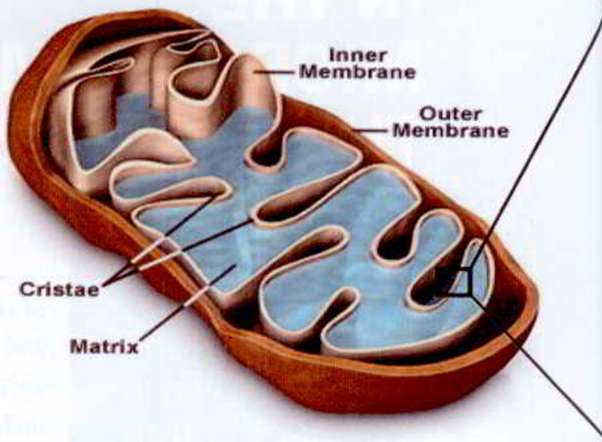
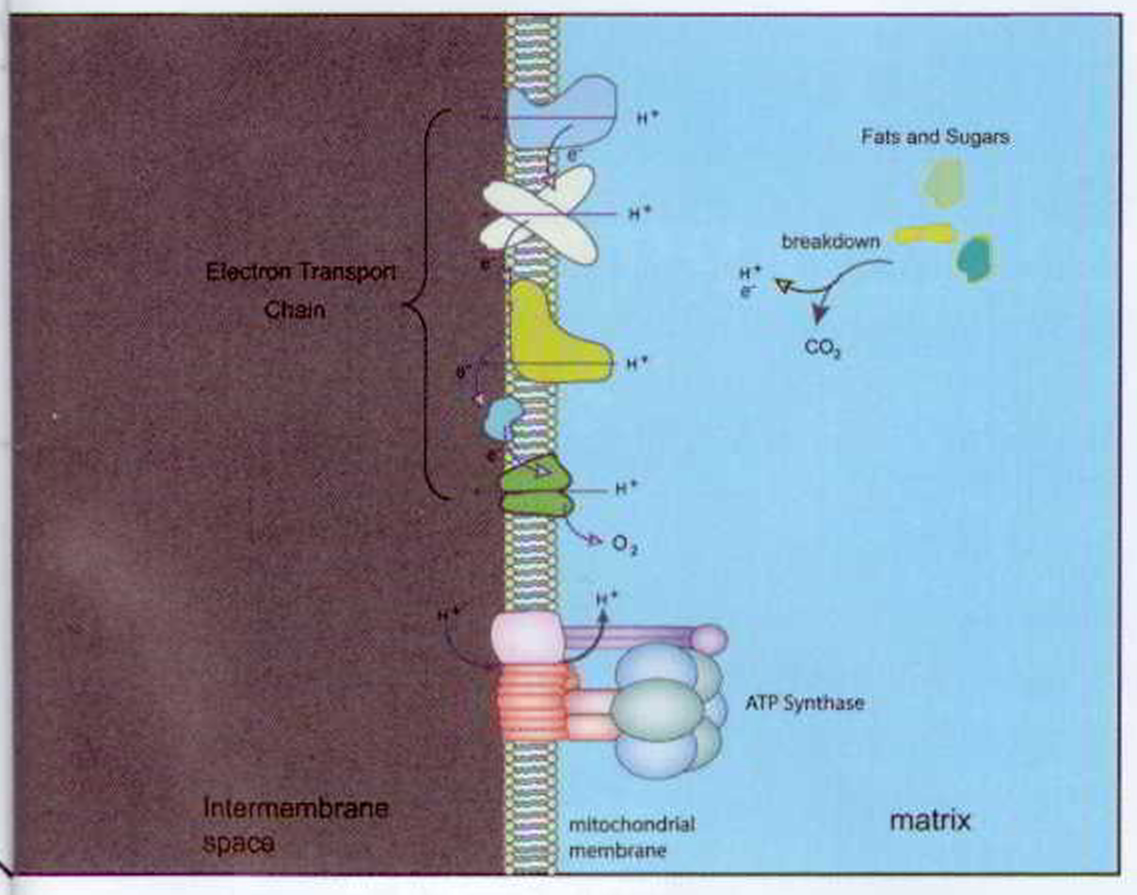
Figure I. Mitochondria work as the power plants of cells. Fats and sugars are broken down in the matrix and H+ ions are pumped out to the intermembrane space by the flow of electrons (e) in the Electron Transport Chain Complex (right), located in the inner membrane. The highly curved structure of the inner membrane (cristae) increases its surface area for the whole process; hence more energy can be produced within the compact volume. Mitochondria are surrounded by an additional outer membrane, so that H+ ions can be concentrated in the intermembrane space and their return to the matrix will be used for energy production.
One may wonder what all this has to do with the production of ATP. So far in the story, a mere one hundred enzymes and more than two hundred chemical reactions have taken place to move hydrogen ions (H+) – obtained from sugars and fats – across the inner membrane. ATP will be produced when H+ ions return to the mitochondria matrix in a highly elaborate mechanism, which will be explained below.
Cellular battery
Pumping out hydrogen ions from one side of die mitochondrial membrane to the other results in a change in the potential energy across die surface. First, since hydrogen ions are charged, the intermembrane space becomes plus-charged, and the matrix minus-charged. This results in an electric voltage of 140 millivolts (mV) across the membrane. This is similar to batteries where electrons are inclined to move from the pointed (minus charged) end to the barbed (plus charged) end, when the two ends are wired. Second, the H+ ions in the intermembrane space become ten times more concentrated than in the matrix. This also favors their return to the matrix, in much the same way as humans wish to migrate from densely populated areas to quieter places, to reach equilibrium. The concentration difference adds another 60 mV to the electric voltage, resulting in 200 mV of net potential. If we think that a typical AA battery has a 1.5 V charge, when eight of these membranes are stacked in serial order, they exceed the voltage of such a battery. However, H+ ions cannot freely pass across the lipid membrane since the membrane does not allow any particle with a net charge to pass. Neither can they use the electron transport chain proteins to go back. This is because they can only take protons from the carrier molecules and these molecules are not present in the intermembrane space. There remains only one place for their return – that is the ATP synthase complex, where energy conversion takes place.
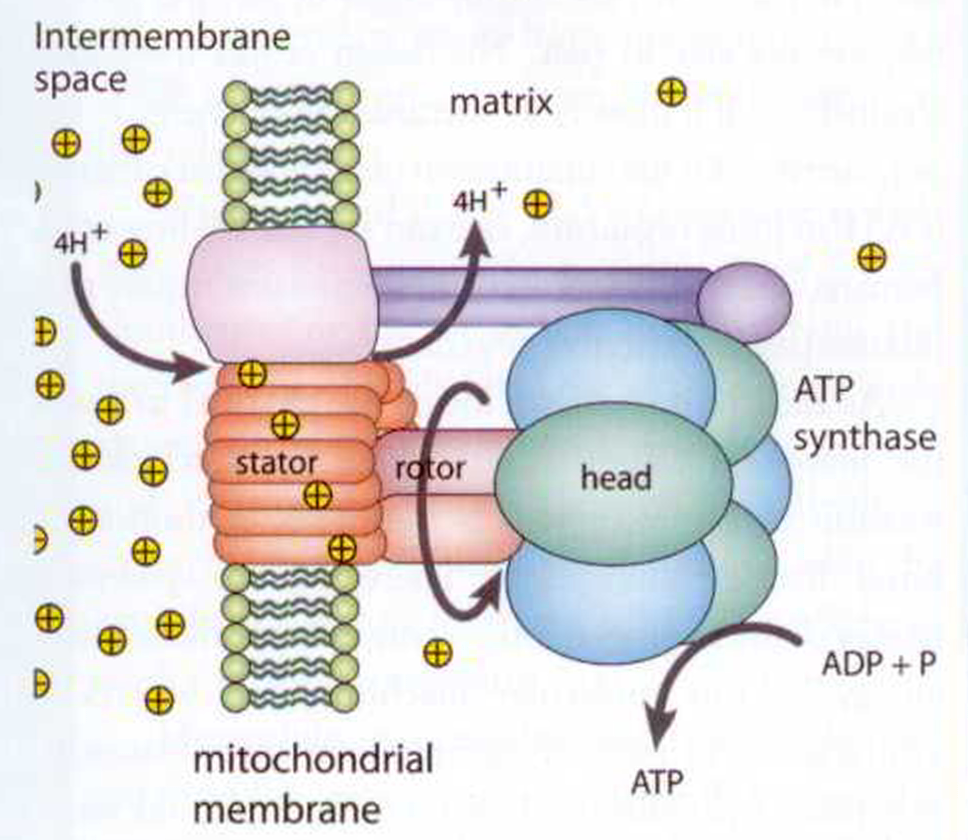
Figure 2. ATP molecules are made by using a similar design of water mills which uses hydraulic potential to rotate the mill. Concentration difference of H+ ions across 100 nm wide lipid membrane of mitochondria create 200 mV of voltage which favors their return to the matrix. 4 H+ ions pass through the proton channel inside the stator of ATP synthase which causes 1200 of rotation of the whole machine. This movement leads to a conformational change of the lollipop shaped head region to make a single ATP molecule. Figure is modified from 1.
ATP synthesis protein machine
The structure of ATP synthase machinery is unique and worthy of mention. It is a multi-protein complex with a molecular mass of 500,000 daltons (1 dalton is equal to the molecular weight of a hydrogen atom). This gigantic protein machine resembles a mushroom which consists of a head, rotor and stator. The head is 10 nm across, and 8 nm high (lnm equals 1 billionth of a meter). This size is actually so tiny that, although it is one of the biggest protein complexes known, billions of billions of these machines would be required to cover a pinhead. ATP synthase is held to the inner membrane by its stator. In the center of the complex, there is a cylindrical rotor which connects die lollipop-shaped head to the stator. The stator is also in direct contact with the head region via an elongated arm which attaches the stator firmly to the head region.
Must strikingly, there is a narrow channel inside the stalk which allows the desperate H' ions to return to their homeland. Yet, in one of the most amazing pieces of machinery that the science has witnessed so far, this channel only allows H+ ions (or protons) to pass along it. If you can imagine how tiny these ions are, you can estimate the width of this channel. Other plus-charged ions, for example Na+ or K+ are slightly bigger in size and hence, they are not able to pass. The design of this marvelous channel is still a mystery to scientists. Since energy is the only currency for the continuation of life and that currency is ATP in living organisms, one can say that the lives of all humans, animals, plants and other organisms require that protons pass through this tiny channel.
As each proton passes inside the channel to reach the matrix, it causes a 120-degree counterclockwise rotation of the rotor that is hundreds of thousands times heavier than itself. Therefore, the potential energy of the hydrogen ions is converted to mechanical energy by diis molecular machine. The way ATP synthase works bears a metaphorical resemblance to manmade hydraulic machines. For example, old water mills, as shown in Figure 2, use hydraulic potential energy to rotate the mill. In a molecular machine, the voltage and concentration gradient is used to rotate the enzyme. Similar mechanisms are used nowadays in turbines placed on water domes to convert the energy from water flow to produce electromagnetic energy via rotation. In ATP synthase, each subunit of the head region can bind to ADP and phosphate, which cannot readily come together to form ATP. The rotation of the stalk causes a structural change in the protein surface of the head region that specifically enables this reaction to form the energy molecule.
It is by this mechanism that cells can produce more than 90% of their energy. Three or four H+ ions are needed to pass through the channel to rotate the whole machine. A single ATP synthase turns at an amazing 24,000 rotations per minute (rpm). Assuming that the engines of highly developed automobiles can only rotate at up to 10,000 rpm, die speed of rotation of this machine is highly impressive. Remarkably, the human body breaks down 100 kilograms of ATP in a day that is roughly equal to 1026 molecules in number. Hence, billions of billions of ATP synthases need to work nonstop to supply our body with the required energy. They consume Hydrogen ions of roughly 1 kilogram of sugars (or fats) to produce sufficient ATP, which is usually what an average person eats per day.
The complexity of energy production in living organisms and use of highly divergent enzymes reminds us of the fact that biological processes are interconnected with each other. In order to start a single vital process, the cell needs to produce energy. Energy is stored in a chemical form of ATP whose synthesis requires enzymes, mitochondria, oxygen and intake of organic molecules. These enzymes are encoded from the genetic code, DNA, by a multi-protein complex, ribosome. This in turn needs energy to make die enzymes out of genetic code. The cycling of all these processes requires the recurrence of all the vital genes for energy production, DNA transcription, translation, cell division, and so forth. In addition, the necessity for the presence of gases, amino acids and other such factors raise questions about how life could have started spontaneously on Earth. Since we already know that the most primitive living organisms, or bacteria, have 30,000 genes and are highly complex, life is highly demanding. The example of how die energy molecule is produced is just a tiny example of the necessities of life. It is impossible to imagine that life could have started on Earth by mere chance.
Make two-way translation of the text:
Refreshing Tips To refresh yourself and continue working even after hours, try these exercises! |
|
Ергономічні поради Аби покращити своє само-почуття і продовжити робо-ту, скористайтеся цими вправами |
With your thumb against the side of your index finger, gently apply pressure above the eye-brows and at several points aro-und the eye. |
|
Складіть разом вказівний та великий пальці й легенько потріть область обличчя над бровами та навколо очей. |
Press gently with your thumb and forefinger on either side of the bridge of your nose, massaging up and down three times. |
|
Притисніть складені разом великий та вказівний пальці до перенісся і зробіть три масажні рухи вздовж лінії носа. |
Use both thumbs to press just below your eyebrows. Hold for three to five seconds. |
|
Великі пальці обох рук при-тисніть до повік і потримайте 3-5 секунд. |
Spread your fingers until you feel the stretch. Hold for five seconds, relax, then bend for five seconds. |
|
Максимально розправте паль-ці й потримайте їх у такому напруженому стані 5 секунд, а потім знову зігніть на 5 секунд. |
Clasp your hands behind your head, and pull your shoulder bla-des in until you feel the stretch. Hold for five to ten seconds, then relax. |
|
Сплетіть пальці рук на поти-лиці і спробуйте дотягнутися до лопаток, поки не відчуєте повне напруження м'язів. По-тримайте руки таким чином 5-10 секунд, потім розслаб-теся. |
Massage the base of your thumb using slight pressure and a slow, circular motion. The same can be done to relieve tension spots in your neck, shoulders and forearms. |
|
Помасажуйте основу велико-го пальця повільними круго-вими рухами. Так само можна послабити напруженість у рі-зних точках шиї, плечей та рук нижче ліктів. |
With your right arm straight in front of you and your fingers relaxed and poin-ting down, flex your wrist up and down five to ten seconds, then relax. |
|
Витягніть перед собою праву руку з розпрямленими, але не напруженими пальцями і 5 10 секунд позгинайте зап'ясток униз-угору, потім розслабте руку. |
Lean forward to touch your toes, hold for five to ten seconds, then slowly return to an upright position. |
|
Нахиліться додолу на 5 се-кунд, торкнувшись кінчиків своїх черевиків, а потім повільно випростайтеся. |
Hold your right leg just below the knee, and hug it to your chest. Hold for five to ten sec-onds. Switch legs and repeat. |
|
Візьміться рукою за ногу під коліном і спробуйте підтяг-нути її до грудей. Потримайте так 10 секунд. Поміняйте ногу і повторіть вправу. |
The above exercises are recommen-ded by the US based Ergonomics Consortium. Info: www.scdetails.com |
|
Ці вправи рекомендовані Ергоно-мічним консорціумом (США). Інфо: www. scdetails.com |
Make two-way translation of the text:
German Expertise in Kyiv |
Німецькі експерти в Києві |
Ever since Ukraine embarked on the reform path, it has been in urgent need of the expertise developed countries possess in both the economic and social spheres. Germany was among the first to offer its support in the form of 'Transform', a long-term consultan-cy program which has been under way for over six years now. Implementing this program is the responsibility of the Coordination Bureau that was, until recently, headed by Mr Claus Bruemmer. |
Cтавши на шлях розвитку реформ, Україна потребувала і потребує за-лучення сучасного досвіду розвине-них країн світу щодо визначення соціальних та економічних аспектів існування суспільства. Німеччина однією з перших запропонувала свою підтримку у вигляді довго-строкової консультативної програми "Трансформ", яка здійснюється по-над 6 років. За її реалізацію відпо-відає Координаційне бюро, що ним донедавна керував пан Клаус Брюммер. |
Mr Bruemmer, what are the most significant achievements made by the Coordination Bureau of which you've been Head since its establishment? Since May 2011, when I was delegated by the Kreditanstalt for Wiederaufbau (KfW) to the German Embassy in Kyiv, I’ve been charged with the task of providing support to Ukraine to help the country in its transformation toward market economy and mature democracy status. Throughout my period as Coordination Bureau Head this goal was pursued through the implementation of about 150 projects with an overall cost of almost 160 million euro, carried out within the framework of the Transform Program initiated by the German Government. I will cite just a few of the examples of projects run in the most critical areas of the Transform program. First and foremost, projects have included advisory services provided to the Government, Parliament and the Administration. Under the leadership of Professor Hoffmann (President, German Institute for Economic Studies, Berlin) and Dr. Siedenberg (Deutsche Bank Research, Frankfurt- am-Main), the Government of Ukraine has been receiving advisory assistance from a team of German economic experts in the area of macroeconomic stabilisation and the restructuring of the national economy. Direct contacts with key Ukrainian decision-makers have been intensive, including several discussions with your President. It is in the domain of economic policy consultation that I would like to see the Ukrainian side pay more attention to German economic experts' recommen-dations with respect to their implemen-tation. If this had previously been the case then some of Ukraine's current problems would now be closer to their solution. |
Пане Брюммер, якими є най-більші досягнення Координацій-ного бюро, керівником якого Ви були з часу його заснування? З того часу, як я у травні 2011 р. був делегований Кредитною уста-новою для відбудови (KfW) в Посольство Німеччини в Києві, моє завдання полягало у наданні під-тримки Україні в процесі ринкової трансформації її економіки та демо-кратичної розбудови її суспільства. Для досягнення цієї мети за час моєї діяльності в Україні на посаді керівника Координаційного бюро KfW було здійснено приблизно 150 проектів на загальну суму майже 160 млн. євро у рамках програми "Трансформ" Уряду Німеччини. Дозвольте мені назвати деякі про-екти з найважливіших напрямків програми "Трансформ" в Україні. Перш за все це консультування Уряду, Парламенту і системи упра-вління. Під керівництвом професо-ра Гоффманна (Президент Німець-кого Інституту економічних дослід-жень, Берлін) та д-ра Зіденберга (Deutsche Bank Research, Франк-фурт-на-Майні) групою німецьких економічних експертів Уряду Укра-їни надається консультативна допо-мога щодо макроекономічної стабі-лізації та реструктуризації народно-го господарства України. Прямі ко-нтакти з високопоставленими поса-довими особами в Україні мають дуже інтенсивний характер: було також проведено декілька бесід із вашим Президентом. Саме в галузі консультування з питань економіч-ної політики я часто бажав би, щоб українська сторона приділяла біль-ше уваги рекомендаціям німецьких економічних експертів стосовно їх-нього втілення. Очевидно в цьому випадку деякі з нинішніх проблем економіки України були б ближчі до свого вирішення. |
In the area of public administration, training and retraining, an impressive number of Ukrainian specialists and managers have been able ro participate in training programs preparing them to meet the high standards and require-ments of Ukraine's administrative system as it reorientates itself towards the market. However, bureaucratisa-tion levels within the Ukrainian admi-nistration system remain a cause for concern. |
У сфері управління німецькими експертами-управлінцями здійсню-ються заходи з навчання та підви-щення кваліфікації; завдяки цьому велика кількість українських фахів-ців і керівників має змогу добре підготуватися, щоб відповідати ви-соким вимогам щодо перебудови системи управління в Україні з орі-єнтацією на ринок. Разом з тим, обсяги забюрократизованості укра-їнської системи управління скоро-чені ще далеко не повною мірою. |
Secondly, we offer advice to the private sector. Special assistance is offered for the creation and development of small and medium-sized enterprises (SMEs) in the form of direct consulting provided by German experts both specialising in the field of business economics and dealing with technical issues. As a result, a good number of Ukrainian companies have had the opportunity to find partners in Germany. German consulting on privatisation issues at a political level in Kyiv and at enterprise level in certain regions of Ukraine is aimed at accelerating the slow pace of the privatisation process and attracting German investors to enterprises up for privatisation. Unfortunately, positive examples in the field of privatisation remain few and far between. |
По-друге, ми надаємо консульта-ції сектору приватних підприємств. Особлива підтримка з боку німецьких експертів у вигляді прямої консультативної допомоги з економіч-них і технічних питань надається при створенні та зміцненні малих і середніх підприємств (МСП). Зав-дяки цьому значна кількість україн-ських підприємств отримала мож-ливість знайти собі партнерів у Ні-меччині. Німецьке консультування з питань приватизації на політич-ному рівні в Києві та на рівні підприємств у певних регіонах Ук-раїни спрямоване на прискорення все ще повільних темпів процесу приватизації підприємств та на за-лучення німецьких інвесторів у цей процес На жаль, у сфері привати-зації все ще надто мало позитивних прикладів. |
Training and retraining programs for experts and administrators in all sectors of the economy are part of the core direction of the Transform Program. In addition to a great deal of workshops conducted in Ukraine, about 3.000 Ukrainians have been on placement in Germany. Three retraining centres were set up for military retirees. Additionally, the Transform Program enabled the establishment of 10 new vocational education centres. The up-to-date level of training in these institutions creates good employment opportunities for graduates. The third priority is the banking sphere. The German-Ukrainian Crediting Fund (GUF) was established in 1997 to facilitate access to lending capital for Ukrainian SMEs. The German Government has already invested 12 million euro, and approximately 20 million euro will be contributed to the GUF by the Ukrainian side. The GUF remains one of the most successful German-Ukrainian projects within the Transform Program framework. Loans issued by the GUF over this period have totalled 30 million euro. In addition to the grant extended by the German side for GUF, in 2012 KfW opened a second credit line worth 30 million euro for the support of Ukrainian SMEs. And finally, we have been involved in support for the agricultural sector. Complementary to agricultural policy consultation at a governmental level, the German-Ukrainian Project for Agricultural Development and Invest-ment (GUAP) is also worthy of note. This project incorporates a livestock breeding, meat and dairy production consulting centre in Cherkasy region, and the Vinnytsia centre for plant- growing production technologies and enterprise economics. Will the priorities and focus of activities change with the arrival of new Head of the Coordination Bureau, Mr. Kirk Mildner? The objectives of the Transform Program have only been met in part. Therefore, in 2013 when the KfW Bureau is headed by Mr. Kirk Mildner, its overall concept is unlikely to change. Plenty of successful projects within the Transform Program will be continued. Other projects, particularly those furthering cooperative ties between German and Ukrainian companies, will be developed. |
Одним із центральних напрямків про-грами "Трансформ" є навчання та під-вищення кваліфікації фахівців і керів-ників в усіх сферах економіки України. Окрім великої кількості семінарів, про-ведених в Україні, майже 3000 українців отримали можливість стажування у Німеччині. Для військовослужбовців, звільнених у запас, були створені 3 центри перекваліфікації. Окрім цього, в рамках програми "Трансформ" в Ук-раїні з'явилося 10 нових осередків про-фесійної освіти. Сучасний рівень навча-ння у них відкриває для випускників непогані шанси працевлаштування. Тре-тій напрямок діяльності – це консульту-вання банківського сектора. З метою полегшення українським МСП доступу до кредитного капіталу на початку 1997 р. був заснований Німецько-український кредитний фонд (НУКФ). Уряд Німеч-чини вніс за цей час у зазначений фонд 12 млн. євро. Приблизно 20 млн. євро будуть внесені в НУКФ українською стороною. НУКФ є одним із найус-пішніших німецько-українських проек-тів у рамках програми "Трансформ". Загальна сума кредитів, виданих НУКФ за весь цей час, склала 30 млн євро. Окрім гранту, наданого німецькою стороною для НУКФ, KfW для підтримки українських МСП відкрила в 2012 р. другу кредитну лінію в розмірі 30 млн євро. І нарешті, консультування у сільсь-кому господарстві. Окрім консультуван-ня з питань аграрної політики на рівні Уряду України, в цьому секторі слід також і насамперед відзначити Німець-ко-український проект аграрного розвит-ку та інвестицій (НУАП). Цей проект включає в себе створення консульта-тивного центру з утримання тварин, а також розвитку м'ясо-молочного госпо-дарства в Черкаській області й Він-ницький центр технологій виробництва в рослинництві та економіки підприємств. Чи зміняться пріоритети й на-прямки діяльності програми у зв'язку з приходом нового керів-ника Координаційного бюро, пана Кірка Мілднера? Мета програми "Трансформ" в Україні досягнута лише частково. Тому у 2013 році, коли Координа-ційне бюро KfW очолить пан Кірк Мільднер, її загальна концепція на-вряд чи зміниться. Велика кількість успішних проектів програми "Тран-сформ" буде продовжена. Інші про-екти, особливо ті, які сприяють встановленню коопераційних зв'яз-ків між німецькими та українськи-ми підприємствами, будуть поглиб-лені. |

